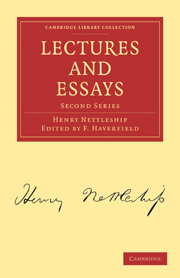Book contents
- Frontmatter
- PREFACE
- Contents
- Dedication
- MEMOIR BY MRS. NETTLESHIP
- I JOHAN NICOLAI MADVIG
- II THE ORIGINAL FORM OF THE ROMAN SATURA
- III LITERARY CRITICISM IN LATIN ANTIQUITY
- IV THE HISTORICAL DEVELOPMENT OF CLASSICAL LATIN PROSE
- V LIFE AND POEMS OF JUVENAL
- VI THE STUDY OF LATIN GRAMMAR AMONG THE ROMANS IN THE FIRST CENTURY A. D.
- VII ON THE PRESENT RELATIONS BETWEEN CLASSICAL RESEARCH AND CLASSICAL EDUCATION IN ENGLAND
- VIII THE MORAL INFLUENCE OF LITERATURE
- IX CLASSICAL EDUCATION IN THE PAST AND AT PRESENT
- X AUTHORITY IN THE SPHERE OF CONDUCT AND INTELLECT
- XI THE RELATIONS BETWEEN NATURAL SCIENCE AND LITERATURE
- BIBLIOGRAPHY
- INDEX
II - THE ORIGINAL FORM OF THE ROMAN SATURA
Published online by Cambridge University Press: 05 October 2010
- Frontmatter
- PREFACE
- Contents
- Dedication
- MEMOIR BY MRS. NETTLESHIP
- I JOHAN NICOLAI MADVIG
- II THE ORIGINAL FORM OF THE ROMAN SATURA
- III LITERARY CRITICISM IN LATIN ANTIQUITY
- IV THE HISTORICAL DEVELOPMENT OF CLASSICAL LATIN PROSE
- V LIFE AND POEMS OF JUVENAL
- VI THE STUDY OF LATIN GRAMMAR AMONG THE ROMANS IN THE FIRST CENTURY A. D.
- VII ON THE PRESENT RELATIONS BETWEEN CLASSICAL RESEARCH AND CLASSICAL EDUCATION IN ENGLAND
- VIII THE MORAL INFLUENCE OF LITERATURE
- IX CLASSICAL EDUCATION IN THE PAST AND AT PRESENT
- X AUTHORITY IN THE SPHERE OF CONDUCT AND INTELLECT
- XI THE RELATIONS BETWEEN NATURAL SCIENCE AND LITERATURE
- BIBLIOGRAPHY
- INDEX
Summary
The name satura, which has given so much trouble to scholars, should to all appearance be compared with feminines formed from adjectives, such as noxia, a fault, dira, a curse, and others of the same kind. The meaning seems to be a medley. Varro quoted by Diomedes (3. p. 486 Keil) says, ‘Satura est uva passa et polenta et nuclei pini-ex mulso consparsi:’ and Festus p. 314, ‘Satura et cibi genus ex variis rebus conditum est et lex multis aliis legibus confecta. Itaque in sanctione legum adscribitur “neve per saturam abrogato aut derogato.”’ How the word first came to be applied to a form of literature is not ascertainable. It may be that its use in this connection was metaphorical; it may be that satura (i. e. satura fabula) was from the first the term for a dramatic performance or a story which was a medley of scenes or incidents. When Juvenal speaks of ‘nostri farrago libelli’ he is doubtless alluding to the then accepted explanation of satura as an olla podrida or dish of various ingredients: but it must be remembered that all our Latin authorities on this matter speak at a time when the word has become fixed in its literary sense of a medley of metres, or of prose and verse. It is probable, however, that the word satura was familiar to the Romans long before the existence of the literary composition so named, and before those who used it had many metres to mingle.
- Type
- Chapter
- Information
- Lectures and EssaysSecond Series, pp. 24 - 43Publisher: Cambridge University PressPrint publication year: 2010First published in: 1895



